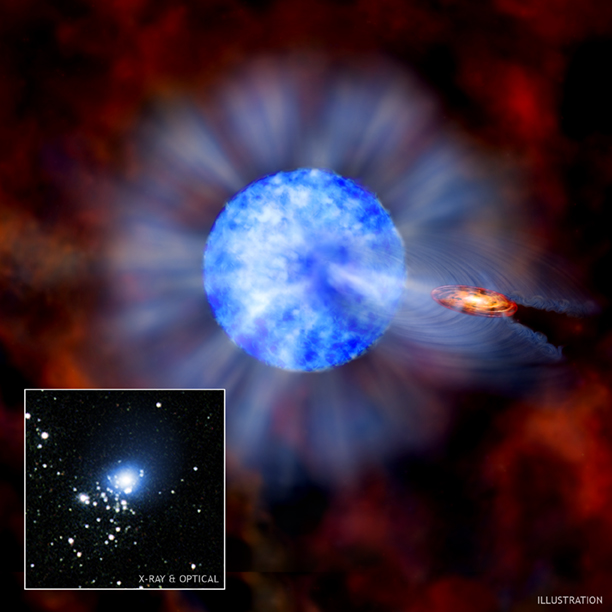
 Credit:Illustration: NASA/CXC/M.Weiss; X-ray: NASA/CXC/CfA/P.Plucinsky et al.; Optical: NASA/STScI/SDSU/J.Orosz et al.
Credit:Illustration: NASA/CXC/M.Weiss; X-ray: NASA/CXC/CfA/P.Plucinsky et al.; Optical: NASA/STScI/SDSU/J.Orosz et al.
The Heaviest Stellar Hole
How massive can black holes get? Some are millions (or maybe billions) of times
more massive than the Sun. These supermassive black holes are actually quite
common, lurking as they do at the centers of many (or most) galaxies. There's
some debate about the existence of slightly less massive black holes, weighing a
few hundred or a thousand solar masses. The best weighed black holes are those
in orbit around normal stars, since the orbital motion is directly related to
mass. In this stellar mass class, there's a new champ. The inset image above
shows a composite image obtained by the Chandra X-ray Observatory in blue, and an
optical image by the Hubble Space Telescope. The
bright, blue Chandra source is an X-ray source called X-7 in the galaxy M33. Observations by
Chandra and by Hubble show that M33 X-7 is a black hole in orbit around a young
massive star. A strong stellar wind from the massive star companion falls into
the black hole and generates strong X-ray emission. The Chandra and Hubble
observations and others constrain the mass of the black hole to be about 16
times the mass of the Sun - a new record for stellar mass black holes. The
illustration above shows an artist interpretation of the system - the blue windy
star losing material into the massive black hole.
<
HEA Dictionary ● Archive
● Search HEAPOW
● Other Languages
● HEAPOW on Facebook
● Download all Images
● Education ● HEAD
>
Each week the HEASARC
brings you new, exciting and beautiful images from X-ray and Gamma ray
astronomy. Check back each week and be sure to check out the HEAPOW archive!
Page Author: Dr. Michael F. Corcoran
Last modified Monday, 26-Feb-2024 17:22:21 EST


